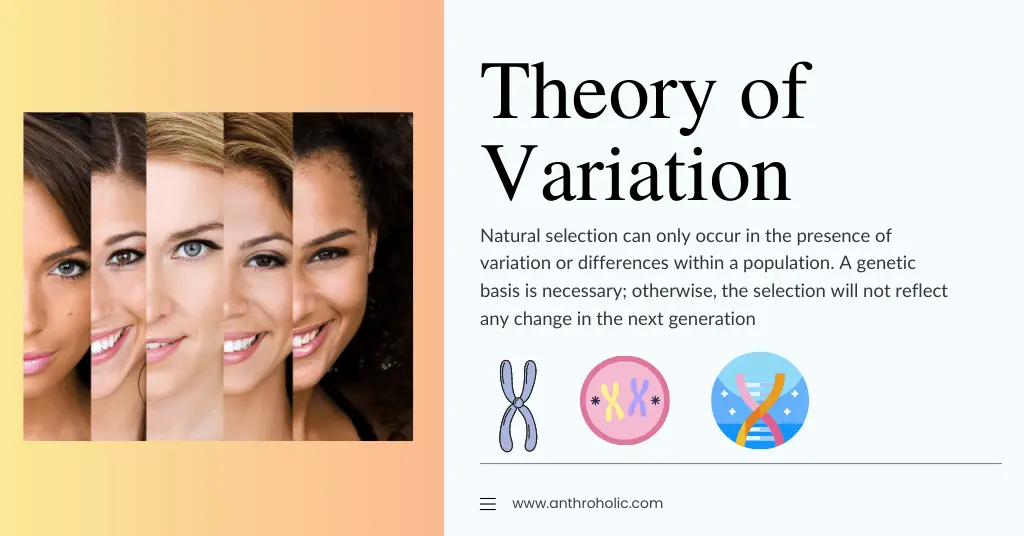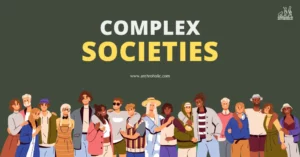AI Answer Evaluation Platform Live Now. Try Free Answer Evaluation Now
Theory of Variation
Human beings exhibit biological diversity and variation. On a cognitive level people naturally want to categorise things and other people in order to make sense of their surroundings. Since the inception of the field of biological anthropology, we have been fascinated by the biological diversity of humans and the factors that contribute to this variation [5]. Early anthropologists were mostly interested in human variation, its magnitude, and its causes. Genetics and anthropometry have been key contributors In determining the precise causes of individual variation and the development of various types of man [4].

Why do anthropologists study human variation?
- First, it’s fascinating and crucial to think about how our species has evolved and how our biological diversity may be comparable to (or distinct from) that of other animal species, such as apes and other primates. Such research may provide us with information on how different from other animal species we are biologically [5].
- Second, anthropologists research contemporary human diversity to comprehend how various biological traits evolved over the course of evolution. Understanding the evolutionary processes that generate and influence diversity will allow us to draw more precise conclusions about the evolution and adaptation of our hominin ancestors, adding to our knowledge of the fossil and the archaeological record [5].
- Third, it’s essential to remember that biological variation among people has ramifications for biomedicine, forensics, and socio-politics [5].
History
- Franz Boas, the founding father of anthropology in the United States, took an integrated approach to studying human nature from a cultural as well as biological perspective. His keen interest in Biology had a significant role in the development of biological (physical) anthropology, and the study of human evolution and variation. His vision laid the foundation for the establishment of biological anthropology as a distinct scientific discipline. Additionally, Czech anthropologist Aleš Hrdlicˇka, and American anthropologist Earnest Albert Hooton were influential in expanding the field of biological anthropology [3].
The mechanism of evolution was first conceived by English naturalists, Charles Robert Darwin and Alfred Russel Wallace [2]. They identified “Natural Selection” or survival of the fittest, as the underlying mechanism for biological variation and evolution [3]. According to Darwin, natural selection operated in nature based on three principles:
i) Most traits of an organism are inherited from the parent to the offspring [2].
ii) All organisms have a higher capacity for reproduction. However, there are limited resources available for the survival and sustenance of the organisms. As a result, each generation faces competition for those resources. This principle was inspired by Thomas Malthus’ theory of population growth [2].
iii) Variations in characteristics among offspring are inherited. According to Darwin and Wallace, offspring with inherited characteristics that provide them with the best chance of competing for scarce resources will survive and produce more offspring. Such inherited characteristics will also be represented in the following generations. As a result, there will be a change in populations over generations. This process was called “descent with modification”. [2].
The process of evolution and human variation
The mechanisms underlying evolution are- natural selection, mutation, genetic drift, and gene flow. The interplay of these evolutionary forces determines genetic variation both within and between populations [3]. Natural selection can only occur in the presence of variation or differences within a population. A genetic basis is necessary; otherwise, the selection will not reflect any change in the next generation [2].
Genetic diversity in a population is a result of: mutation and sexual reproduction. The primary source of new alleles, or new genetic variation in any population, is a mutation, a change in the DNA [2]. The significance of diversity in DNA markers for comprehending evolutionary change in primates, particularly humans, was recognised by biological anthropology [3].
Franz Boas identified the importance of the study of growth and development, for understanding human variation. Since his earliest research, biological anthropologists have looked into every aspect of the human life cycle; birth, ageing, and death [3].
The study of variation in biological anthropology (18th century- 19th century)
The core subject matter of biological (physical) anthropology is the study of human origins and human variation. This interest dates back to the period of Enlightenment of the 18th century. This was also a time when the concept of “race” was formalised and racial classification systems were introduced. Until the mid-20th century, race was a dominant theme in physical anthropology. It served as a typological characterization of human variation [3]. German physician Johann Friedrich Blumenbach (1752–1840), the father of physical anthropology, classified humanity into five races: American, Caucasian, Ethiopian, Malayan, and Mongolian. He is also credited with developing the field of craniology [4].
Studies of anatomy, craniology, bone biology, human origin, and race dominated biological anthropology in the second half of the nineteenth century. Most physical anthropologists received training as physicians and anatomists and as such their methods of primary data collection were confined to anthropometric, osteometric measurements and morphological observations. The field lacked interest in evolution, races were considered fixed, studies utilised typological approaches to the study of race, studies rarely utilised scientific methods of hypothesis testing, and there was little understanding of evolution and adaptation. American physical anthropologist, Sherwood Larned Washburn founded a “new physical anthropology” which focused on the evolution of humans and primates as well as human variation, with genetics serving as a key unifying concept [1].
New physical anthropology and human variation
After 1950, the concept of “population” replaced race, as a unit of diversity. The framework was provided by Sherwood Washburn, Theodosius Dobzhansky, and Julian Huxley, who were influenced by contemporary population geneticists [5]. Washburn’s new physical anthropology was aimed at studying primate and human evolution and human variation as an addition to earlier Darwinian evolutionary theory and genetics [3].
The concept of population and race held two important connotations in the 1950s and 1960s:
- On one hand, the term “races” was then simply defined as populations that have different gene/genes. On the other hand, a “population” came to be seen as a group of individuals who are potentially able to interbreed because of a similar geographic proximity, language, ethnicity, culture, and/or values” [5].
- “Population” was seen as a limited interbreeding group with minimal gene flow between themselves and other groups of humans. People from the same population will likely have many genetic features in common. These studies primarily dealt with phenotypic traits [5].
Sherwood Washburn’s new physical anthropology (1951)
- Sherwood Washburn was influential in rediscovering fieldwork with fresh perspectives in physical anthropology, emphasising history and the evolutionary process. Paleo-anthropology and primatology were the new areas of study for Washburn. He was one of several anthropologists who adopted contemporary biological and scientific developments and set the path for the current biosocial context of physical anthropology [4].
- With a return to Darwinian evolutionary theory and genetics serving as a key unifying element, Washburn’s “new physical anthropology” focused on primate and human evolution and human variation. In addition, descriptive studies were to give way to research using scientific design and hypothesis testing, and races were to be examined as populations rather than as essentialist ‘types’. These ideas inspired developments in the field of physical anthropology and reflected changes that were already occurring [3].
Human population genetics in anthropology has been revolutionised by DNA research, the Human Genome Project, and its development towards the discovery of the variation linked with the human genome [3]. Research in primatology has advanced significantly, particularly in studies of naturalistic behaviour and the ecology of non-human primates. This is partially due to our fascination with our closest relatives among mammals as well as the destruction of habitat and the need to protect threatened and endangered primates. One of the initial goals of biological anthropology was to better understand the origins of non-human primates and humans, as well as the web of our evolutionary pathways. Discoveries in palaeoanthropology are now helping to achieve this objective [1]. Darwinian medicine is a recent area of study where applications of evolutionary theory are providing insights into the principles underlying the well-being and health of humans. In addition, biomedical anthropology trains students of health care in epidemiological and anthropological principles [3].
Methods to study human variations
Several initiatives were undertaken in the nineteenth century to analyse and quantify human variation using visual and statistical techniques, especially by natural historians who laid the foundation for biological anthropology. For example, statistical methods were used to interpret “variation in size”. The concept of “ideal types” or “averages” were introduced for this purpose. While such “ideal types” or averages were effective for classifying radically different species, dealing with closely related organisms and “type” made things more challenging. As such, the understanding of the scope of human variation became challenging and the traditional methods only led to an increasing number of “types”. Major types were used to categorise people into a few “basic” races, obscuring the diversity of each individual. New approaches and procedures were developed to comprehend human variations and evolution as our understanding of biological anthropology and human biology expanded [1].
The major methods and techniques are briefly discussed below: [1]
- Anthropometry: It is described as the scientific study of human body measurements made using standardised units, reference points, and instruments. The measurement of human growth and the Anthropometric Standardization Reference Manual are two standards that are seen as being essential for the science of anthropometry. Anthropometry is further subdivided into: somatometry, cephalometry, osteometry and craniometry. The major tools of anthropometry are: stadiometer, anthropometer, spreading callipers, medical scale, osteometric board, pelvimeter, goniometer, craniophore, mandibulometer, etc.
- Somatoscopy: It is the description of morphological physical characteristics of people based on visual observation of morphological attributes. The visual evaluation of physical characteristics is done following a set of standardised observations, which also introduces some subjectivity. These visual observations include things like skin tone, hair colour, eye colour, face shape, lip shape, and eye and nose form. Biological anthropology’s goal of understanding human variation and identifying shared morphological characteristics for a group of people, a community, or an ethnic group is furthered by the study of somatoscopic observations.
- Serology: It is the scientific study of blood and its properties. Due to their relatively simple manner of inheritance, blood attributes are widely utilised in anthropological genetics.
- Dermatoglyphics: In physical or biological anthropology, dermatoglyphics is a significant method for examining a wide range of human physical characteristics. A complicated genetic basis can be identified in the examination of variations in the pattern of ridges seen on the fingers, palms, and soles.
- Polymorphism at the DNA level: Biological anthropologists have learned a great deal about human variation at the DNA level because of the advancements in the Human Genome Project. There have been numerous DNA variants found in the human genome recently. Over 600,000 loci (mainly SNPs) have been investigated by anthropologists and biologists after they obtained DNA samples from modern human populations from all over the world.
References
[1] APPROACHES OF TRADITIONAL AND MODERN BIOLOGICAL ANTHROPOLOGY. (n.d.). EGyan Kosh. https://egyankosh.ac.in/bitstream/123456789/65789/1/Unit4.pdf
[2] Etheredge, S. (2019). Physical Anthropology (2nd ed.). https://www.canyons.edu/_resources/documents/academics/onlineeducation/Antrhopology101Final.pdf
[3] Larsen, C. S. (Ed.). (2010). A Companion to Biological Anthropology. https://doi.org/10.1002/9781444320039
[4] Physical/Biological Anthropology: Applied Physical Anthropology. (n.d.). EPG Pathshala. https://epgp.inflibnet.ac.in/epgpdata/uploads/epgp_content/anthropology/01._physical___biological_anthropology_/29._applied_physical_anthropology/et/7223_et_et_29.pdf
[5] Rivera, M. B. C. (n.d.). Race and Human Variation. Americananthro. https://explorations.americananthro.org/wp-content/uploads/2019/09/Chapter-13-Race-and-Human-Variation-3.0.pdf




